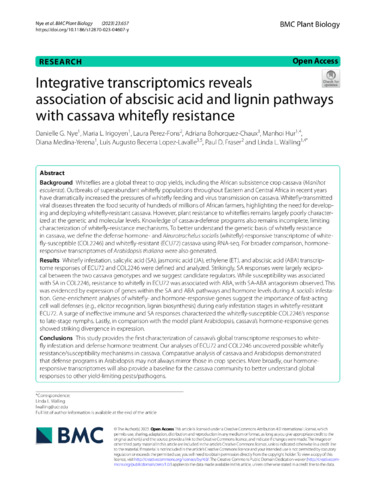Integrative transcriptomics reveals association of abscisic acid and lignin pathways with cassava whitefly resistance
Background Whiteflies are a global threat to crop yields, including the African subsistence crop cassava ( Manihot esculenta ). Outbreaks of superabundant whitefly populations throughout Eastern and Central Africa in recent years have dramatically increased the pressures of whitefly feeding and virus transmission on cassava. Whitefly-transmitted viral diseases threaten the food security of hundreds of millions of African farmers, highlighting the need for developing and deploying whitefly-resistant cassava. However, plant resistance to whiteflies remains largely poorly characterized at the genetic and molecular levels. Knowledge of cassava-defense programs also remains incomplete, limiting characterization of whitefly-resistance mechanisms. To better understand the genetic basis of whitefly resistance in cassava, we define the defense hormone- and Aleurotrachelus socialis (whitefly)-responsive transcriptome of whitefly-susceptible (COL2246) and whitefly-resistant (ECU72) cassava using RNA-seq. For broader comparison, hormone-responsive transcriptomes of Arabidopsis thaliana were also generated. Results Whitefly infestation, salicylic acid (SA), jasmonic acid (JA), ethylene (ET), and abscisic acid (ABA) transcriptome responses of ECU72 and COL2246 were defined and analyzed. Strikingly, SA responses were largely reciprocal between the two cassava genotypes and we suggest candidate regulators. While susceptibility was associated with SA in COL2246, resistance to whitefly in ECU72 was associated with ABA, with SA-ABA antagonism observed. This was evidenced by expression of genes within the SA and ABA pathways and hormone levels during A. socialis infestation. Gene-enrichment analyses of whitefly- and hormone-responsive genes suggest the importance of fast-acting cell wall defenses (e.g., elicitor recognition, lignin biosynthesis) during early infestation stages in whitefly-resistant ECU72. A surge of ineffective immune and SA responses characterized the whitefly-susceptible COL2246’s response to late-stage nymphs. Lastly, in comparison with the model plant Arabidopsis, cassava’s hormone-responsive genes showed striking divergence in expression. Conclusions This study provides the first characterization of cassava’s global transcriptome responses to whitefly infestation and defense hormone treatment. Our analyses of ECU72 and COL2246 uncovered possible whitefly resistance/susceptibility mechanisms in cassava. Comparative analysis of cassava and Arabidopsis demonstrated that defense programs in Arabidopsis may not always mirror those in crop species. More broadly, our hormone-responsive transcriptomes will also provide a baseline for the cassava community to better understand global responses to other yield-limiting pests/pathogens.

